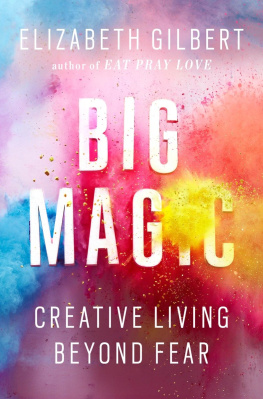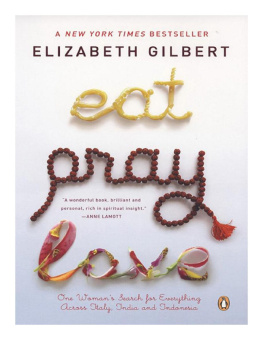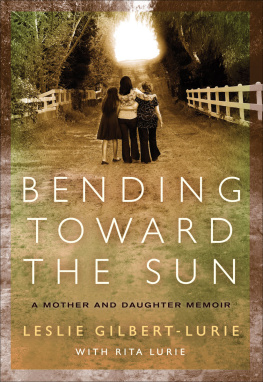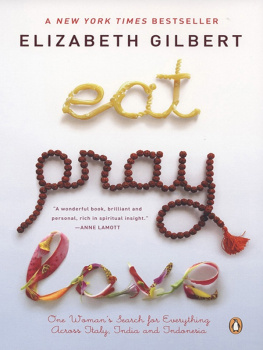
Elizabeth Gilbert
Eat, Pray, Love
2006
For Susan Bowen
who provided refuge even from 12,000 miles away
Tell the truth, tell the truth, tell the truth.
Sheryl Louise Moller
Introduction or How This Book Works or The 109th Bead
When you're traveling in India-especially through holy sites and Ashrams-you see a lot of people wearing beads around their necks. You also see a lot of old photographs of naked, skinny and intimidating Yogis (or sometimes even plump, kindly and radiant Yogis) wearing beads, too. These strings of beads are called japa malas. They have been used in India for centuries to assist devout Hindus and Buddhists in staying focused during prayerful meditation. The necklace is held in one hand and fingered in a circle-one bead touched for every repetition of mantra. When the medieval Crusaders drove East for the holy wars, they witnessed worshippers praying with these japa malas, admired the technique, and brought the idea home to Europe as rosary.
The traditional japa mala is strung with 108 beads. Amid the more esoteric circles of Eastern philosophers, the number 108 is held to be most auspicious, a perfect three-digit multiple of three, its components adding up to nine, which is three threes. And three, of course, is the number representing supreme balance, as anyone who has ever studied either the Holy Trinity or a simple barstool can plainly see. Being as this whole book is about my efforts to find balance, I have decided to structure it like a japa mala, dividing my story into 108 tales, or beads. This string of 108 tales is further divided into three sections about Italy, India and Indonesia-the three countries I visited during this year of self-inquiry. This division means that there are 36 tales in each section, which appeals to me on a personal level because I am writing all this during my thirty-sixth year.
Now before I get too Louis Farrakhan here with this numerology business, let me conclude by saying that I also like the idea of stringing these stories along the structure of a japa mala because it is so structured. Sincere spiritual investigation is, and always has been, an endeavor of methodical discipline. Looking for Truth is not some kind of spazzy free-for-all, not even during this, the great age of the spazzy free-for-all. As both a seeker and a writer, I find it helpful to hang on to the beads as much as possible, the better to keep my attention focused on what it is I'm trying to accomplish.
In any case, every japa mala has a special, extra bead-the 109th bead-which dangles outside that balanced circle of 108 like a pendant. I used to think the 109th bead was an emergency spare, like the extra button on a fancy sweater, or the youngest son in a royal family. But apparently there is an even higher purpose. When your fingers reach this marker during prayer, you are meant to pause from your absorption in meditation and thank your teachers. So here, at my own 109th bead, I pause before I even begin. I offer thanks to all my teachers, who have appeared before me this year in so many curious forms.
But most especially I thank my Guru, who is compassion's very heartbeat, and who so generously permitted me to study at her Ashram while I was in India. This is also the moment where I would like to clarify that I write about my experiences in India purely from a personal standpoint and not as a theological scholar or as anybody's official spokesperson. This is why I will not be using my Guru's name throughout this book-because I cannot speak for her. Her teachings speak best for themselves. Nor will I reveal either the name or the location of her Ashram, thereby sparing that fine institution publicity which it may have neither the interest in nor the resources for managing.
One final expression of gratitude: While scattered names throughout this book have been changed for various reasons, I've elected to change the names of every single person I met-both Indian and Western-at this Ashram in India. This is out of respect for the fact that most people don't go on a spiritual pilgrimage in order to appear later as a character in a book. (Unless, of course, they are me.) I've made only one exception to this self-imposed policy of anonymity. Richard from Texas really is named Richard, and he really is from Texas. I wanted to use his real name because he was so important to me when I was in India.
One last thing-when I asked Richard if it was OK with him if I mentioned in my book that he used to be a junkie and a drunk, he said that would be totally fine.
He said, "I'd been trying to figure out how to get the word out about that, anyhow."
But first-Italy
Eat, Pray, Love
Eat, Pray, Love
I wish Giovanni would kiss me.
Oh, but there are so many reasons why this would be a terrible idea. To begin with, Giovanni is ten years younger than I am, and-like most Italian guys in their twenties-he still lives with his mother. These facts alone make him an unlikely romantic partner for me, given that I am a professional American woman in my mid-thirties, who has just come through a failed marriage and a devastating, interminable divorce, followed immediately by a passionate love affair that ended in sickening heartbreak. This loss upon loss has left me feeling sad and brittle and about seven thousand years old. Purely as a matter of principle I wouldn't inflict my sorry, busted-up old self on the lovely, unsullied Giovanni. Not to mention that I have finally arrived at that age where a woman starts to question whether the wisest way to get over the loss of one beautiful brown-eyed young man is indeed to promptly invite another one into her bed. This is why I have been alone for many months now. This is why, in fact, I have decided to spend this entire year in celibacy.
To which the savvy observer might inquire: "Then why did you come to Italy?"
To which I can only reply-especially when looking across the table at handsome Giovanni-"Excellent question."
Giovanni is my Tandem Exchange Partner. That sounds like an innuendo, but unfortunately it's not. All it really means is that we meet a few evenings a week here in Rome to practice each other's languages. We speak first in Italian, and he is patient with me; then we speak in English, and I am patient with him. I discovered Giovanni a few weeks after I'd arrived in Rome, thanks to that big Internet cafe at the Piazza Barbarini, across the street from that fountain with the sculpture of that sexy merman blowing into his conch shell. He (Giovanni, that is-not the merman) had posted a flier on the bulletin board explaining that a native Italian speaker was seeking a native English speaker for conversational language practice. Right beside his appeal was another flier with the same request, word-for-word identical in every way, right down to the typeface. The only difference was the contact information. One flier listed an e-mail address for somebody named Giovanni; the other introduced somebody named Dario. But even the home phone number was the same.
Using my keen intuitive powers, I e-mailed both men at the same time, asking in Italian, "Are you perhaps brothers?"
It was Giovanni who wrote back this very provocativo message: "Even better. Twins!"
Yes-much better. Tall, dark and handsome identical twenty-five-year-old twins, as it turned out, with those giant brown liquid-center Italian eyes that just unstitch me. After meeting the boys in person, I began to wonder if perhaps I should adjust my rule somewhat about remaining celibate this year. For instance, perhaps I could remain totally celibate except for keeping a pair of handsome twenty-five-year-old Italian twin brothers as lovers. Which was slightly reminiscent of a friend of mine who is vegetarian except for bacon, but nonetheless I was already composing my letter to Penthouse:
Next page












